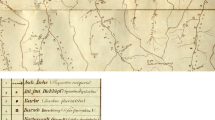Abstract
Data from a survey on the distribution of fish species in Switzerland were used to test the hypothesis that species richness of the fish fauna is closely related with the structure, heterogeneity and complexity of the ecotonal zone in rivers. Species richness increased with increasing structural heterogeneity and variability of the ecotone in rivers wider than 2.5 m at altitudes below 500 m. In lowland brooks and in rivers at higher altitudes other factors seemed to be more important than morphological variability: alpine rivers are more often left natural than lowland rivers and salmonid stocking is more important in these naturally species poor fish communities. The proportion of threatened species was higher if riverbed and -banks were natural, the slope was flat, the variability in depths and sediment composition was high and if the ecotonal zone was well structured. Specialized species such as nase and riffle minnow only occurred in larger rivers, whereas in small and medium-sized rivers with low morphological variability these threatened species were missing. On the other hand, ubiquitous species such as chub, roach and perch, occurred in all sizes of rivers, even if morphological variability was small. Low morphological variability and its impact on the composition of the fish community is mainly a consequence of past human interventions. Therefore river management has to take into account the ecological requirements of specialized species and increasing the variability of riverbed and banks would considerably contribute to the conservation of endangered fish species.
Similar content being viewed by others

References
Barila, T. Y., R. D. Williams & J. R. Stauffer, 1981. The influence of stream order and selected stream bed parameters on fish diversity in Raystown branch. Susquehanna river drainage. Pennsylvania. J. appl. Ecol. 18: 125–131.
Friedrich, G., J. Lacombe (eds), 1992. Ökologische Bewertung von Fliessgewässern. G. Fischer, Stuttgart (Limnologie aktuell Bd. 3): 462 pp.
Gorman, O. T. & J. R. Karr, 1978. Habitat Structure and Stream Fish Communities. Ecology 59: 507–515.
Huet, M., 1949. Apercu des relations entre la pente et les populations piscicoles des eaux courantes. Schweiz. Z. Hydrol. 11: 332–351.
Jungwirth, M. & H. Winkler, 1983. Die Bedeutung der Flussbettstruktur für Fischgemeinschaften. Österr. Wasserwirtschaft 35: 229–234.
Jungwirth, M., 1984. Die fischereilichen Verhältnisse in Laufstauen alpiner Flüsse, aufgezeigt am Beispiel der östereichischen Donau. Österr. Wasserwirtschaft 36: 103–111.
Kirchhofer, A., B. Zaugg & J.-C. Pedroli, 1990. Rote Liste der Fische und Rundmäuler der Schweiz. Doc. Faun. Helv. 9: 23 pp.
Naiman, R., H. Décamps & F. Fournier, 1989. The role of land/inland water ecotones in landscape management and restoration: a proposal for collaborative research. Unesco, Paris, MAB Digest 4: 93 pp.
Noss, R. F., 1990. Indicators for monitoring biodiversity: A hierarchical approach. Conservation Biology 4: 355–364.
Pedroli, J.-C., B. Zaugg & A. Kirchhofer, 1991. Verbreitungsatlas der Fische und Rundmäuler der Schweiz. Doc. Faun. Helv. 11: 206 pp.
Peter, A., 1991. Ansprüche von Fischen an die Morphologie und Hydrologie der Bäche. Mitteilungen EAWAG 32: 9–13.
Schiemer, F. & T. Spindler, 1989. Endangered fish species of the Danube river in Austria. Regulated Rivers 4: 397–407.
Schiemer, F. & H. Waidbacher, 1992. Strategies for Conservation of a Danubian Fish Fauna. in P. J. Boon, P. Calow & G. E. Petts (eds), River Conservation and Management. J. Wiley & Sons, Chichester: 363–382.
Sheldon, A. L., 1968. Species diversity and longitudinal succession in stream fishes. Ecology 49: 193–198.
Spiegler, A., G. Imhof, M. Katzmann, B. Pelikan, 1989. Strukturökologische Methode zur Bestandesaufnahme und Bewertung von Fliessgewässern. Bundesministerium für Land- und Forstwirtschaft, Wasserwirtschaftskatatster, Wien: 34 pp.
Townsend, C. R., A. G. Hildrew & J. Francis, 1983. Community structure in some southern English streams: the influence of physicochemical factors. Freshwat. Biol. 13: 521–544.
Vischer, D., 1986. Schweizerische Flusskorrektionen im 18. and 19. Jahrhundert. Mitt. der Versuchsanstalt für Wasserbau. Hydrologie und Glaziologie (ETH) 84: 78 pp.
Welcomme, R. L., 1992. River Conservation — Future Prospects. in P. J. Boon, P. Calow & G. E. Petts (eds), River Conservation and Management. J. Wiley & Sons, Chichester: 453–462.
Author information
Authors and Affiliations
Rights and permissions
About this article
Cite this article
Kirchhofer, A. Morphological variability in the ecotone — an important factor for the conservation of fish species richness in Swiss rivers. Hydrobiologia 303, 103–110 (1995). https://doi.org/10.1007/BF00034048
Issue Date:
DOI: https://doi.org/10.1007/BF00034048



